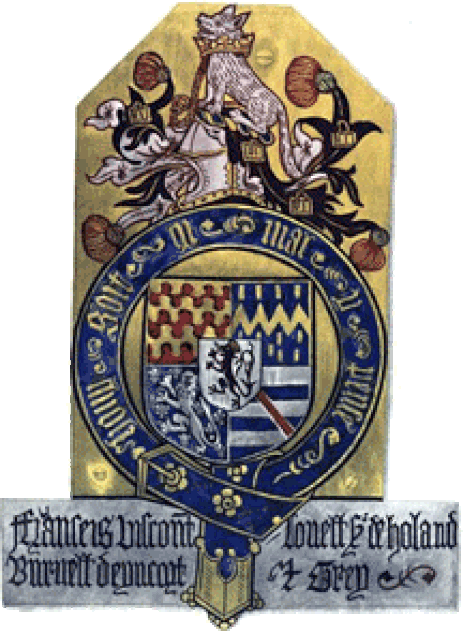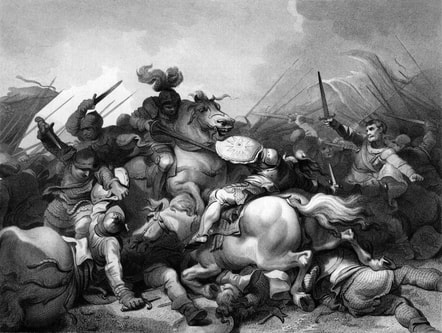
Was Francis, Viscount Lovel buried in Gedling Church?
Summary
On his way to supervise the defence of the South Coast against Henry Tudor’s invasion, Francis wrote a document instructing his wife to found a chantry to enable a priest to pray for his soul should he die in battle. His wife had difficulty complying with his wishes because she had no sons to help her and Francis disappeared far away from where she lived. The one member of her extended family able to assist her was Thomas Stapleton who lived seventy miles from Gedling in Huddersfield. When Thomas died in 1525, his will showed that he held land in Gedling which had been previously designated to pay a chantry priest so that priest must have been the one appointed to officiate in Francis’ chantry.
Read on to find out more about Francis and his connection with the Princes in the Tower!
Who was Francis Lovel?
Francis was born in 1456, the son of John, Eighth Lord Lovel, one of he wealthiest people in the land. Both his parents died by the time he was ten years old so he was brought up by Henry, 5th Lord FtzHugh at Ravensworth castle in North Yorkshire. Francis married Henry’s daughter Anne but they had no children.
In 1483 Francis was created Viscount Lovel by Edward IV and was made a member of the Order of the Garter. The image on the left shows the plate that was attached to his stall in St George’s Chapel at Windsor Castle. The shield shows the arms of the five lordships he held: Lovel, D’ Eincourt, Holland and Grey reading clockwise from top left with Burnell in the centre and is surrounded by the emblem of the Garter.
The crest has a wolf-hound which was the origin of a saying popular at the time that ‘The Catte, the Ratte and Lovel our Dogge rule all England under the Hogge’ meaning that the trio of William Catesby, Sir Richard Ratcliffe and Francis Lovel governed the country on behalf of Richard III whose emblem was a white boar.
The combination of the income from his five lordships and his collaboration with Richard III made Francis one of the wealthiest and powerful people in the land.
Summary
On his way to supervise the defence of the South Coast against Henry Tudor’s invasion, Francis wrote a document instructing his wife to found a chantry to enable a priest to pray for his soul should he die in battle. His wife had difficulty complying with his wishes because she had no sons to help her and Francis disappeared far away from where she lived. The one member of her extended family able to assist her was Thomas Stapleton who lived seventy miles from Gedling in Huddersfield. When Thomas died in 1525, his will showed that he held land in Gedling which had been previously designated to pay a chantry priest so that priest must have been the one appointed to officiate in Francis’ chantry.
Read on to find out more about Francis and his connection with the Princes in the Tower!
Who was Francis Lovel?
Francis was born in 1456, the son of John, Eighth Lord Lovel, one of he wealthiest people in the land. Both his parents died by the time he was ten years old so he was brought up by Henry, 5th Lord FtzHugh at Ravensworth castle in North Yorkshire. Francis married Henry’s daughter Anne but they had no children.
In 1483 Francis was created Viscount Lovel by Edward IV and was made a member of the Order of the Garter. The image on the left shows the plate that was attached to his stall in St George’s Chapel at Windsor Castle. The shield shows the arms of the five lordships he held: Lovel, D’ Eincourt, Holland and Grey reading clockwise from top left with Burnell in the centre and is surrounded by the emblem of the Garter.
The crest has a wolf-hound which was the origin of a saying popular at the time that ‘The Catte, the Ratte and Lovel our Dogge rule all England under the Hogge’ meaning that the trio of William Catesby, Sir Richard Ratcliffe and Francis Lovel governed the country on behalf of Richard III whose emblem was a white boar.
The combination of the income from his five lordships and his collaboration with Richard III made Francis one of the wealthiest and powerful people in the land.

Francis’ Indenture
During the Spring of 1485, it became increasingly apparent that Henry Tudor was planning to invade England and Francis Lovel was charged by Richard III with the vital task of overseeing the defence of the south coast.
Francis recognised that the invasion by Henry Tudor represented a significant threat to his life and liberty, so on his way to Southampton, he drew up an indenture stating his wishes if he should not survive the invasion. At the time Francis was about 30 years old had no reason to anticipate dying from natural causes.
The indenture starts by referring to a charter Francis had made a year earlier, in which he conveyed five of his manors in Northamptonshire to a group of feoffees (trustees) for them to hold in trust for his wife Anne. It continues by instructing her to appoint two priests to celebrate Mass to help him ‘gain forgiveness and goodwill’ which meant that Francis was asking her to found a chantry to enable prayers for his soul in accordance with current beliefs in the Doctrine of Purgatory wherever and whenever he happened to die.
"l want that Anne the wife of me, the said Francis Viscount Lovell, orders two priests of good description, fame and conditions, to celebrate to help me the said Francis gain forgiveness and goodwill, which l want situated in Cambridge or Oxford and read two times a year in their university for thirty years fully completed." [1]
During the Spring of 1485, it became increasingly apparent that Henry Tudor was planning to invade England and Francis Lovel was charged by Richard III with the vital task of overseeing the defence of the south coast.
Francis recognised that the invasion by Henry Tudor represented a significant threat to his life and liberty, so on his way to Southampton, he drew up an indenture stating his wishes if he should not survive the invasion. At the time Francis was about 30 years old had no reason to anticipate dying from natural causes.
The indenture starts by referring to a charter Francis had made a year earlier, in which he conveyed five of his manors in Northamptonshire to a group of feoffees (trustees) for them to hold in trust for his wife Anne. It continues by instructing her to appoint two priests to celebrate Mass to help him ‘gain forgiveness and goodwill’ which meant that Francis was asking her to found a chantry to enable prayers for his soul in accordance with current beliefs in the Doctrine of Purgatory wherever and whenever he happened to die.
"l want that Anne the wife of me, the said Francis Viscount Lovell, orders two priests of good description, fame and conditions, to celebrate to help me the said Francis gain forgiveness and goodwill, which l want situated in Cambridge or Oxford and read two times a year in their university for thirty years fully completed." [1]
Henry's Invasion
Francis’ defence of the south coast was ineffective because Henry’s army landed in Wales and defeated Richard at the Battle of Bosworth on 22 August 1485. It is not known whether Francis himself had time to return to fight in the battle but his name was included in the Act of Attainder passed by Henry’s Parliament, on 7 November 1485, which designated him a traitor meaning that he had forfeit to Henry ‘all Castelles, Mannors, Lordshipps, Hundreds’.
This action took away all of the wealth and power Francis had enjoyed under Richard and made him a fugitive in his own land.
Click HERE to learn about why Purgatory was so important in the Middle ages and how Anne Lovel responded to Francis instructions.
Reference
1 National Archives ref. E40/4790, Indenture whereby Francis, Viscount Lovell, desires that his undermentioned feoffees shall convey to Anne Lovell...
An English translation may be found in Michele Schindler, Lovell Our Dogge, (2019), pages 187-8
Francis’ defence of the south coast was ineffective because Henry’s army landed in Wales and defeated Richard at the Battle of Bosworth on 22 August 1485. It is not known whether Francis himself had time to return to fight in the battle but his name was included in the Act of Attainder passed by Henry’s Parliament, on 7 November 1485, which designated him a traitor meaning that he had forfeit to Henry ‘all Castelles, Mannors, Lordshipps, Hundreds’.
This action took away all of the wealth and power Francis had enjoyed under Richard and made him a fugitive in his own land.
Click HERE to learn about why Purgatory was so important in the Middle ages and how Anne Lovel responded to Francis instructions.
Reference
1 National Archives ref. E40/4790, Indenture whereby Francis, Viscount Lovell, desires that his undermentioned feoffees shall convey to Anne Lovell...
An English translation may be found in Michele Schindler, Lovell Our Dogge, (2019), pages 187-8
